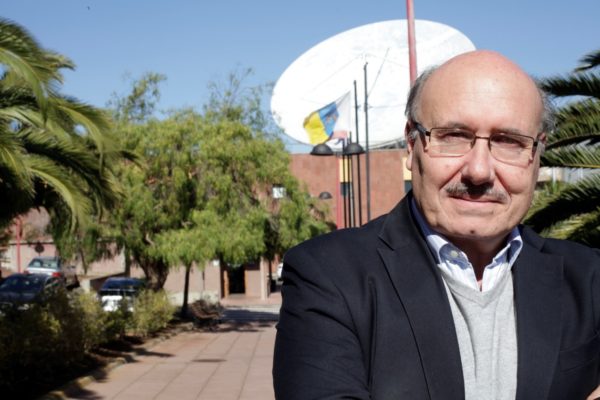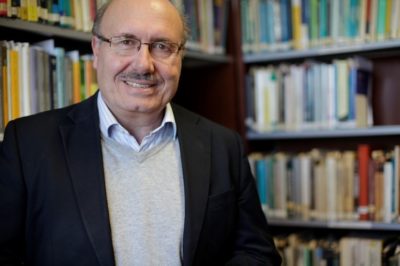admin | 19/03/2019
“These days astrophysicists are focusing their attention on trying to understand the very high energy phenomena that occur in the universe and the physical mechanisms in their nature”
The Institute of Astrophysics of the Canary Islands (IAC) is an international research center in Spain with headquarters in La Laguna, Tenerife, where most of the scientific, technological, and support staff normally work. It is also where the facilities to develop scientific instruments are located.
Its director, Rafael Rebolo López, spoke with us about the progress of astronomical research in Spain and the challenges it currently faces.
1. What is the IAC? What is its role? And what are its primary contributions?
The Institute of Astrophysics of the Canary Islands (IAC) is a public research organization that is legally recognized as a Public Consortium with participation from the Ministry of Science, Innovation and Universities; the Government of the Canary Islands; the University of La Laguna; and the Spanish National Research Council. Its primary mission is astrophysical research, development of associated technology, training of research personnel, and scientific outreach.
Our observatories—located on El Teide, Tenerife, and Roque de los Muchachos, La Palma—are considered to be among the world’s best due to the quality of their skies and their scientific facilities. More than 20 countries participate there in collaboration with Spain to operate more than 40 astronomical facilities. Of note due to its scientific power is the Gran Telescopio Canarias, the largest optical and infrared telescope in operation in the
world, a project with support from the IAC, in which Spain provides 90% and Mexico and the University of Florida the remaining 10%.

The IAC maintains a high level of scientific production that is published in the best astrophysics journals, providing more than one publication every day. In the past five years, more than 2,000 research projects have been published in fields as varied as solar physics, planetary systems, stellar and interstellar physics, the physics of galaxies, astroparticles, and cosmology. In addition, the Institute carries out important technological work, building sophisticated instruments for astronomical observation covering fields such as cryomechanics, electronics, detectors, optics, and software. At the center there are more than 200 scientists, including around 70 young graduate students who are writing their doctoral theses, more than 100 senior engineers, and a similar number of technical and administrative staff.
2. How has astronomical observation progressed thanks to technology?
New detection technology has been a key component in the exploration of the universe. The main qualitative jump in recent decades was in the field of detectors, where efficiency and sensitivity have improved significantly. This is also true for complex optical systems, multiplexer systems, that can multiply the number of objects under observation over the same time period. With regard to telescopes, we have gone from monolithic mirrors to segmented mirrors like the Gran Telescopio Canarias, which was one of the first of this type in the world. This technology is now the foundation to build the giant telescopes of the future.
3. A part of what your telescopes do is to transmit data to satellites. What kind of information is sent and what is it used for?
Apart from the constant astronomical observation programs, innovative experiments are also conducted involving optical communication with satellites to improve information transmission capabilities. In this field, we collaborate primarily with the European Space Agency, which has an optical station for this purpose at the Teide Observatory that has been operational for several decades. Communication and quantum entanglement experiments have also been conducted at our observatories.
4. There is no doubt that there are astronomical factors that affect the climate, but what capabilities do the IAC observatories have to prevent potential hazards or meteorological catastrophes?
In the observatories, meteorological measurements are recorded continuously so we can create the best schedule for our scientific work. These measurements are, of course, open to the scientific community and, in particular, to the Spanish National Weather Agency, which is the group responsible for making predictions in this field.
“Any technological project that uses recent breakthroughs has implicit risk, but this risk is mitigated by exhaustive planning in all the steps of its implementation, based on a very detailed preliminary concept in which all the aspects, both technical and human, are predicted”
5. Is it true that the progress of astronomical research is so extensive that in 10 or 15 years, we could reproduce the conditions of the Sun on the Earth, producing our own endless source of energy without radioactive waste? If so, how could a discovery like that affect the energy industry and society?
For several decades now, scientists have understood the mechanism of energy generation in our Sun, essentially hydrogen fusion. This is a practically endless source of energy that, if able to be reproduced in a controlled way, would be an enormous breakthrough for humanity. The technological project that is pursuing this leap is called ITER. It is located in France and is managed by a large international consortium that Spain also participates in. These days, astrophysicists are focusing their attention on trying to understand the very high energy phenomena that occur in the universe and the physical mechanisms in their nature. I am certain that in the future this detailed knowledge will be useful and will provide a service to humanity.
6. What risk factors exist in an astronomical investment and how do you try to mitigate them?
Any technological project that uses recent breakthroughs has implicit risk, but this risk is mitigated with exhaustive planning in all the steps of its implementation. This plan involves a very detailed preliminary or concept design in which we attempt to predict all the aspects—both technical and human—as well as the time and financial scales. Sometimes these projects last 20 years, and more than five or six of them are spent on planning and design. For example, we have the case of special missions like Planck, which the IAC participated in alongside many European and American institutes. We also must constantly perform management and supervision—especially in the phases of construction, integration, and testing—and follow the best practices in quality control. But the key in any project is, above all else, to have a top-tier human team.
7. Finally, could you tell us what are the most important projects that you will work on in the future?
The IAC aims, first of all, to undertake cutting-edge science and to try to resolve important problems in astrophysics: improving our understood of how the Sun changes, identifying where there are planets like Earth, describing them, determining if they have developed life, understanding how black holes are formed and what happens inside them, understanding the nature of matter and energy in the universe.
To answer these questions, we need very sophisticated measurement instruments and we must create state-of-the-art telescopes to install in our observatories or in space. The IAC is working to develop some of the most cutting-edge telescopes in their class as well as the instruments they require.
For example, we are leading the European Solar Telescope (EST) project, built to study the Sun. We are also participating in the world’s largest gamma-ray observatory, the Cherenkov Telescope Array (CTA). Both projects, which have been recognized as strategic scientific facilities for Europe, will have their headquarters at the Canary Islands Observatories. More than 20 countries—not only from Europe—are participating in these projects.
In addition, we also work for European Space Agency (ESA) space missions and we are contributing to the first scientific instruments of what will be world’s largest telescope, the European Large Telescope, which will be up and running in six years and is currently under construction. And, of course, it continues to be a priority for us to improve the instruments of our Gran Telescopio Canarias, which is currently fully functioning.
Rafael Rebolo López (Cartagena, 1961)
 With a degree in Physical Sciences from the University of Granada and a doctorate in Astrophysics from the University of La Laguna, Rafael Rebolo has been a CSIC scientist since 1988.
With a degree in Physical Sciences from the University of Granada and a doctorate in Astrophysics from the University of La Laguna, Rafael Rebolo has been a CSIC scientist since 1988.
P
A professor of Physical Science Research at the Max Planck Institute for Astronomy in Heidelberg, he has been the Director of the IAC since 2013.
He has directed research projects in observational cosmology, stellar/substellar and exoplanet physics. His more than 400 scientific articles include innovative contributions to the study of the cosmic microwave background and the cosmological implications of its anistropy, to the study of nucleosynthesis processes in the Big Bang and the progenitors of black holes, to the study of the chemical composition of the oldest stars and of stars that orbit black holes.
He was part of the discovery of giant exoplanets, super-Earths, and Earth-like planets. With his team, he discovered the first brown dwarfs (intermediate objects between stars and planets).
Throughout his extensive career, he has created technological programs for astrophysics observatories and has participated in the Planck space missions for the Cosmic Microwave Background, Euclid, which studies dark energy and the ESPRESSO spectrograph for the VLT, designed to detect rocky planets in the habitable zone.
Additionally, he leads the QUIJOTE consortium to detect the trace of gravitational waves from the Big Bang. A member of the Max Planck Society and a scholar of the Royal Academy of Exact, Physical, and Natural Sciences, he has received the Science and Technology Prize and the Jaime I Research Prize from Iberdrola, the Canarias Research Prize, the Jules Janssen Prize for Astronomy, and the National Prize for Research in Physical Sciences.





